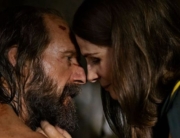When schools or cities want to cut their budgets, the arts are always one of the first and easiest targets. However, as David Petersen’s documentary Lift points out, the arts are necessary. And for kids who are trying to survive in a difficult, often unfair world, they can be life-changing and lifesaving.
Project LIFT, run by New York Theater Ballet, offers dance classes to children experiencing housing insecurity. Steven Melendez, an alumnus of LIFT and a former professional dancer, visits shelters and tries to bring kids into the program. Focusing on three students in particular—Victor, Yolanssie, and Sharia—Petersen reveals how much kids can benefit from dance, as well as the challenges they face. For these kids, this program can be the lifeline they need, a constant that gives them structure and a place to freely express themselves. It’s something that Melendez understands too well. Early on, he returns to the Bronx shelter where he lived for several years, and the emotions of seeing the place again overwhelm him to the point of becoming physically ill.
At the shelters, he meets kids who are in different stages of dealing with their transient presents. Yolanssie is upbeat and open in the beginning, and seems born with physical gifts for ballet. Sharia is eager and clearly looking for anything that will get her away from this life. But some kids appear to be already shut down, unable to muster the hope to be interested in anything.
Through the years, Melendez tries to remain a part of the kids’ chaotic lives. When the talented Victor goes through a teen phase of irresponsibility, Melendez is there to try to make sure he doesn’t waste his opportunity, shepherding him as a dancer with a real professional future. When Yolanssie disappears, he tracks her down and finds a teenager who now channels her energy and anger into dangerous aggression and school problems rather than dance. His blunt talk with her about how close she is to ruining her life, as well as an invitation to participate in a dance he is choreographing, seem to set her on a safer path. For Sharia, her ability to keep up with the dance program is complicated by her family’s constant moves and her loving parents’ difficult work schedules.
The director makes all these points by just capturing the events of these students’ lives, letting their stories speak for themselves. At first, it seems as though their stories are being told contemporaneously, but as the film goes on, it becomes somewhat apparent that they are not. I found myself thinking, “Wait, Victor is 13 now, but Yolanssie still looks like she’s 11? Now Yolanssie is 14? But Sharia still seems like she’s 10?” Some titles with years would have been welcomed, just so viewers don’t find their minds wandering as they try to match dates up.
I will confess that I love dance documentaries, so maybe Lift was an easy sell for me. Yet there still is a lot of value here even for viewers who don’t know a jeté from a plié. While watching this moving film, you may feel frustrated by the barriers so many kids face, but also inspired by what they can do when given a chance. Yes, I cried multiple times. But they were mostly happy tears.

















Leave A Comment